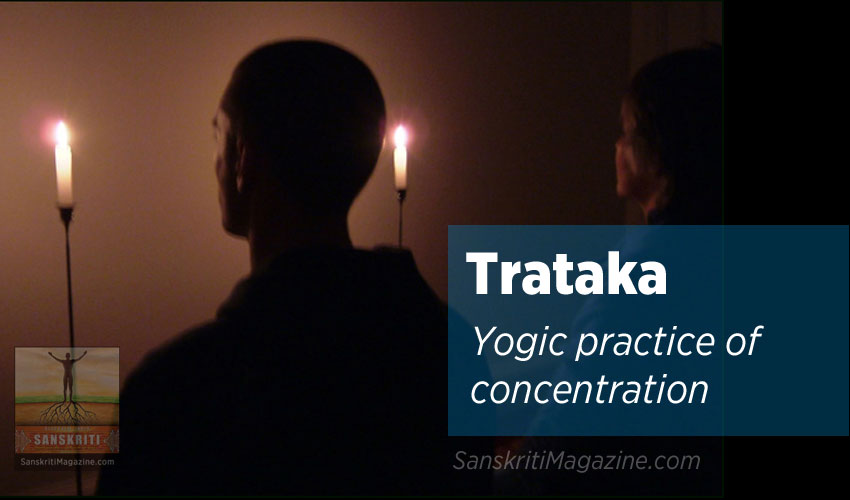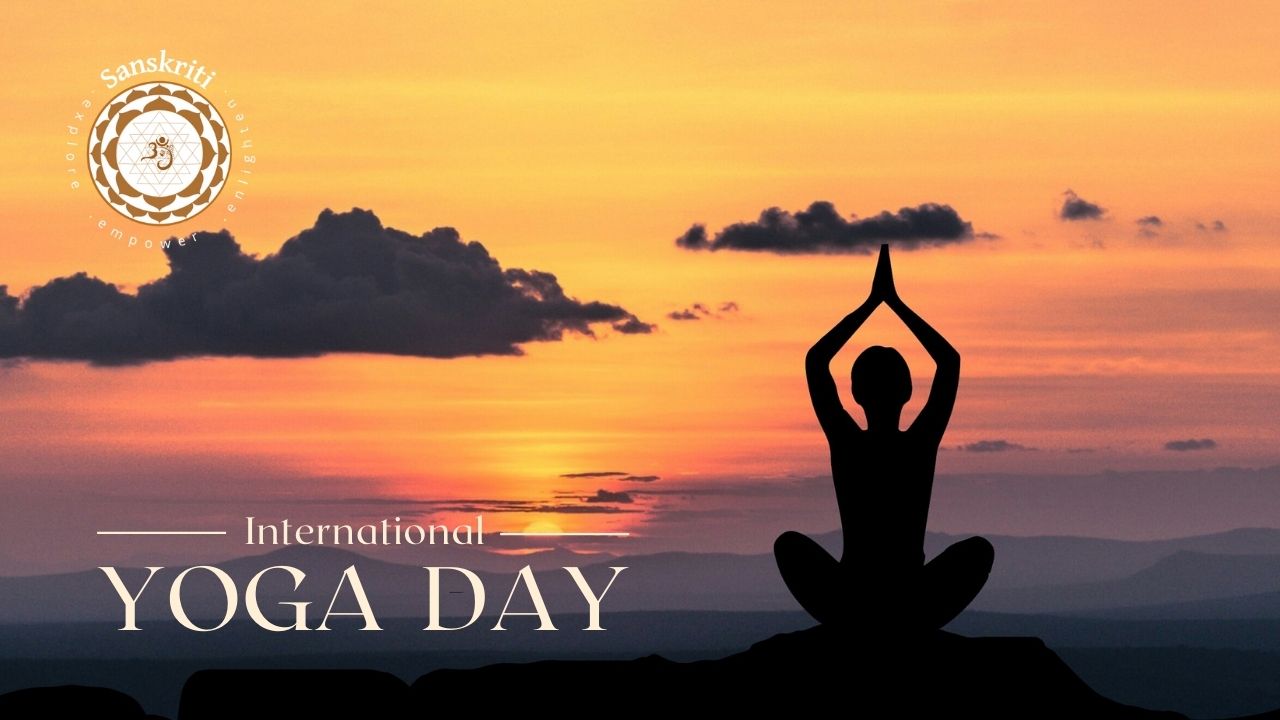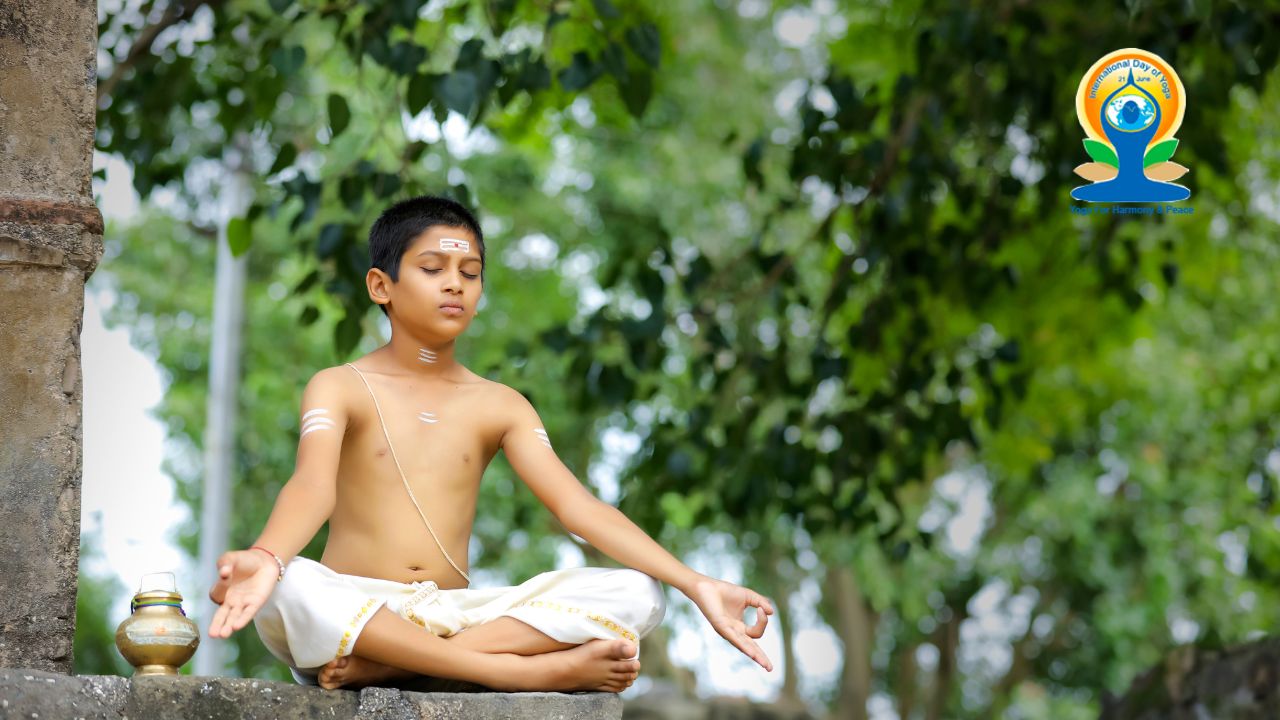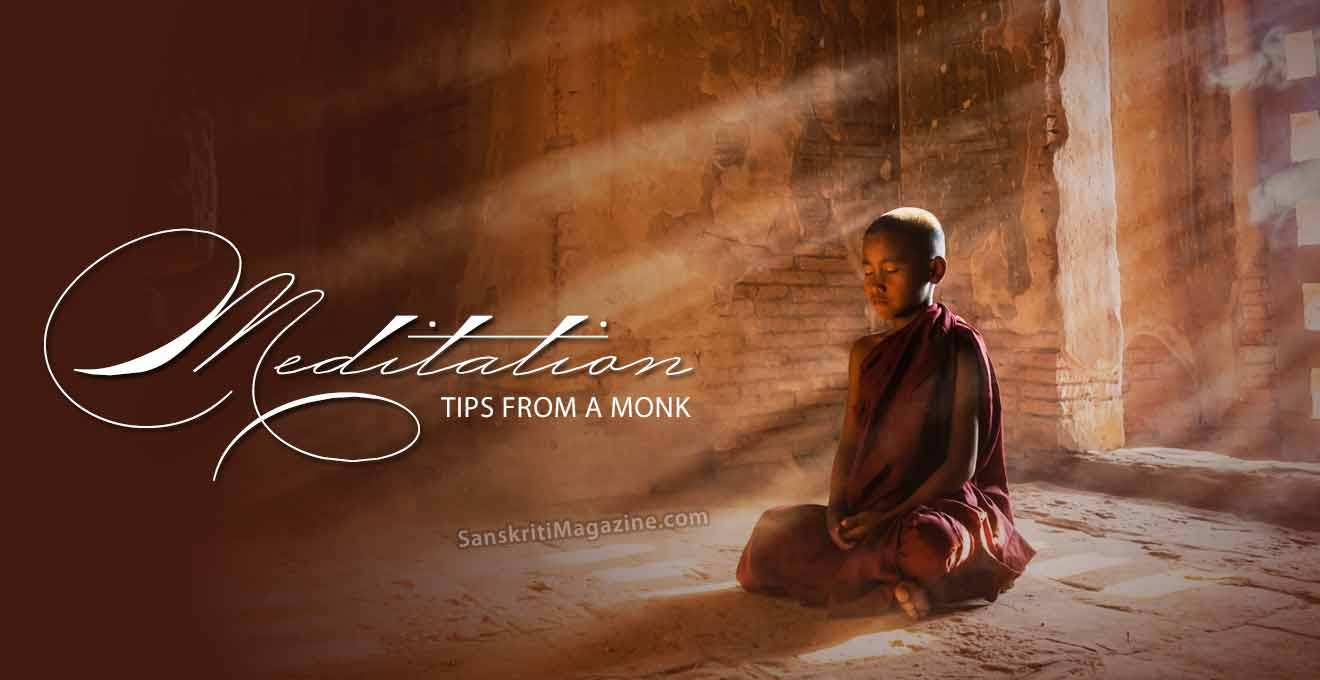Looking intently with an unwavering gaze at a small point until tears are shed, is known as trataka by the acharyas. ~ (“Hatha Yoga Pradipika” 2:31)
Trataka is a deceptively simple but powerful practice. Trataka means ‘to gaze steadily at a fixed point’ and there are two forms of the practice. One is ‘bahiranga’ or external trataka and the other is ‘antaranga’ or internal trataka. Bahiranga is easier to practise because one simply has to gaze at an object or symbol. However, antaranga trataka involves clear and stable inner visualisation of an object.
In the practice of trataka an object is gazed at until its subtle form manifests in front of the closed eyes. The point of concentration is usually a symbol or object which activates the inner potential and can absorb the mind. The symbol most commonly used is a candle flame, because even after the eyes are closed, the impression remains naturally for some time, and then antaranga trataka can easily be performed. The purpose of focusing the eyes on an external object is to arouse the internal vision and make it absolutely steady by stopping the eye movements.
Trataka is a process of concentrating the mind and curbing its oscillating tendencies. The one-pointed concentration of mind is termed ‘ekagrata’. There are numerous distractions which obstruct ekagrata. Association and identification through the eyes and sight are major contributing factors to this leakage. Furthermore, the eyes move constantly, either in large movements (saccades), or tremors (nystagmus). Even when the eyes are focused on an external object the perception is always fluctuating due to these spontaneous movements. When the same object is constantly seen, the brain becomes accustomed or habituated, and soon stops registering that object. Habituation coincides with an increase of alpha waves indicating diminished visual attention to the external world. When alpha waves are produced it indicates that particular areas of the brain have ceased functioning. This is the case,, not only with trataka, but with any practices of concentration. When the awareness is restricted to one unchanging sense stimulus, like touch or sound, the mind is ‘turned off’. Complete absorption in a single perception induces withdrawal of contact with the external world.
In trataka the result is a ‘blanking out’ of visual perception, and in the wake of this suspension, the central nervous system begins to function in isolation. This is known by yogis as sushumna. When the brain is isolated from the sense modalities and from the associated mental processes, ideas, memories, etc., triggered by these thought impressions, spiritual consciousness emerges. The higher brain, liberated from time and space, is experienced-There are many other equally effective symbols for trataka apart from the candle flame, such as a crystal hall, a shiva lingam, yantra, mandala, the full moon, a star, the rising or setting sun (when it is orange, not yellow), a chakra, the symbol om or your own shadow. These are the most effective, but trataka can also be done on a rose, a tree, a mountain, the sea, the sky, a rock, a black dot or any object of your choice. However, one should be careful when selecting the trataka symbol. If for example, you concentrate on the form of Kali you will arouse that aspect of your inner being if you are not beyond it. You may even manifest Kali and be terrified by her fearsome form. A steady flame of light is the most practical and safest, unless your guru advises you otherwise.
Technique
Bahiranga trataka
Practise in a dark room which is free from drafts and insects – place a candle at arms length in front of you with the flame at eye level – it is important that the flame does not flicker in the least – sit in a comfortable meditative pose, preferably siddhasana/siddha yoni asana and place the hands on the knees in either gyana or chin mudra – relax your whole body, close your eyes and prepare yourself as for any meditative practice -make yourself cairn and quiet and be prepared to keep your body perfectly still throughout the entire practice -practise kaya sthairyam for a few minutes – open your eyes and gaze at the middle portion of the flame (ideally one should focus on the red tip of the wick as it does not move due to draft) – gaze for as long as possible without blinking and without strain until the eyes begin to water or tire – you will be able to increase the time gradually with practice to ten minutes – remain the silent witness (sakshi) throughout, observing all thoughts and feeling which may arise – when you close your eyes keep them fixed an the impression in chidakasha – if the afterimage moves, bring it back to the centre and continue gazing until the impression disappears -once you can stabilise the afterimage, study it and look intently at its colour.
Antaranga trataka
Prepare yourself as in the technique for bahiranga trataka – keep the eyes closed throughout and concentrate on your symbol – if you have no symbol try to visualise a point of light, like a twinkling star, or a crescent or full moon – try to see the object clearly and steadily in the dark space or chidakasha, in front of the closed eyes – practise for five to twenty minutes. (This practice has to be cultivated over a long time.)
Trataka can be done at any time but is more effective when performed on an empty stomach. The most suitable time is between four and six in the morning after asana and pranayama practice. If you wish to delve deeper into the mind, trataka should be done late at night before going to bed and before japa or meditation. If there is an uncontrollable How of thought during trataka, mantra japa should also be done at the same time. One can also imagine that one is breathing in a straight line from, the point of concentration through the eyebrow centre and straight back to ajna chakra at the back of the head. When you close your eyes to gaze at the counter image, continue with this awareness.
Benefits
According to the ‘Hatha Yoga Pradipika’ of Swatmarama, ‘Trataka eradicates all eye diseases, fatigue and sloth and closes the doorway creating these problems. It should carefully be kept secret like a golden casket.” Trataka benefits not only the eyes but a whole range of physiological and mental functions. It is therapeutic in depression, insomnia allergy, anxiety, postural problems, poor concentration and memory.
Trataka unlocks the inherent energy of the mind and channelises it to the dormant areas of the unconscious. Yogi Swatmarama mentions the arousal of clairvoyance but other capacities such as telepathy, telekinesis, psychic healing, etc., can develop. Not only that, further results of one-pointedness of mind are strong willpower, improved memory and concentrative ability. Physiologically, trataka relieves eye ailments such as eye strain and headache, myopia, astigmatism and even early stages of cataract. The eyes become clear bright, able to see the reality beyond appearances.
What is the difference between trataka, yoga nidra and hypnosis?
Swami Niranjan: The ultimate object of all these techniques is the same but the actual techniques are different. The common aim of yoga nidra, trataka, and hypnosis is developing the faculties and stopping the dissipation of mind. Once we are able to stop the dissipated nature of the mind we are able to go deep into ourselves and awaken the faculties of our unconscious and subconscious minds.
In yoga nidra we direct our mind wilfully through the experiences of visualisation, memory, sensations, etc.; all the different activities of consciousness are experienced. But yoga nidra does not stop here. It takes the individual through a process of self-awareness leading to the discovery of the inner nature or the deeper mind. The aim of yoga nidra is not only to provide relaxation or awaken man’s creative nature but also to give control and direction to the unmanifested qualities.
Traditionally it is said that there are more than eighty stages of yoga nidra. It starts with simple body awareness and ‘so-called’ astral travelling but includes awareness of our inner self, knowledge of the karan sharir (causal body). It is a vast technique.
Trataka, on the other hand, is a very simple method of concentration or dharana. The simple act of holding the image in the mind for an extended period of time helps to locus the dissipated energies of the senses, intellect and emotions at one point – ekagrata. This acute or undivided concentration in which we are able to focus the mind wilfully, first of all on a manifest object and later on some concept or idea, is the purpose of trataka. It provides an unfluctuating and unwavering state of mind.
Hypnosis is different. It acts like a catalyst to awaken certain deep-rooted impressions of the mind and dormant brain centres. A proficient hypno-therapist can achieve this and it is good for those who lack willpower and self-confidence. However, if you have enough willpower and self-confidence, hypnosis is not necessary although it is a very powerful tool if used, correctly.
In hypnosis one is guided to a point where awareness of body and mind is lost and one is under the control of the directions of the hypnotist. In yoga nidra however, even in the state of unconsciousness there is awareness. Most people will have experienced at least once that they have been aware that they are dreaming or they are aware that they are sleeping. Yuga nidra provides this continuous awareness even in deeper states of mind.
One instruction given during trataka, is ‘Keep the mind entirely devoid of thought’. Surely anyone able to do this would be beyond the practice of trataka?
Swami Niranjan: In the initial practice of trataka, whenever one begins to concentrate the mind intently on an object, whether it be a candle flame or anything else, at that point the dissipated faculties of mind are focused in concentration of the object. As long as you practise external trataka the mind remains steady and concentration remains sharp, even though, after trataka, again the same dissipated nature of mind will manifest. However, during the practice, the pratyahara of the senses induces the pratyahara of the mental faculties, and it is the dharana of the mental faculties which is actually known as antaranga, trataka. Holding the mental faculties at one point of concentration and not allowing them to waver, is the subtle aspect of trataka.
Even in the matra by Yogi Swatmarama where he describes trataka, he speaks of ‘sukshma lakskya’ or ‘the subtle direction’, and according to Yoga this would mean awareness of the mental faculties, and holding the concentration of the mental Faculties, rather than the concentration of the sensory perceptions. It is here that keeping the mind entirely devoid of thought will help in pin-pointing and bringing together, the states of manas, buddhi and chitta.
In the practice of antaranga trataka, manas, buddhi and chitta, the three faculties, are centred in the object of concentration. Unless the concentration becomes so intense that there is no separation of ‘me’ as the practitioner, and the object and the process of practice, one cannot experience the higher states, one cannot experience samadhi, and one cannot go beyond the state of ahamkara-ego.
~ Swami Niranjan











